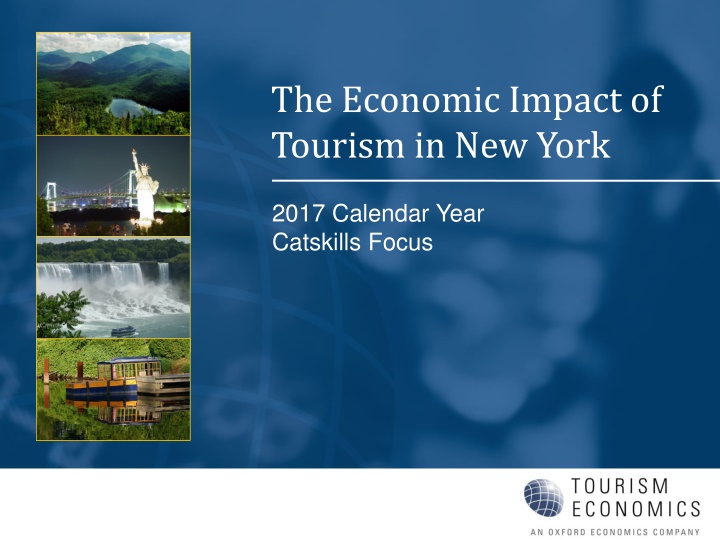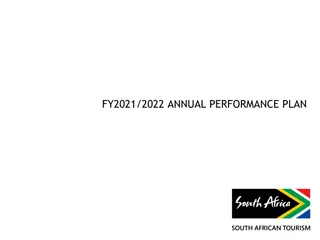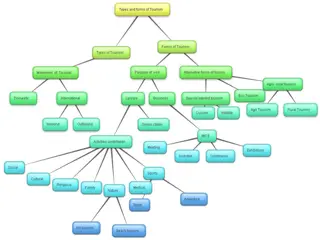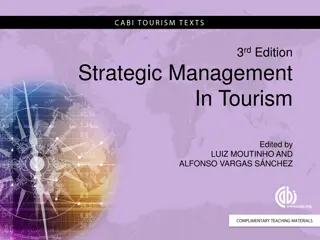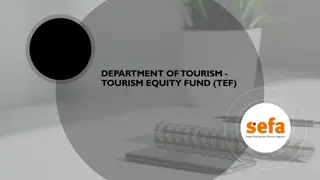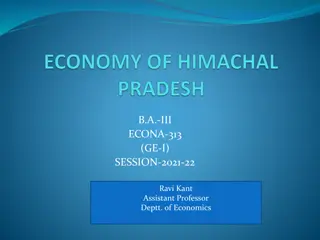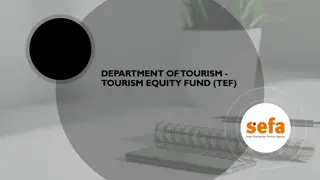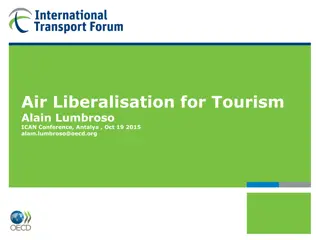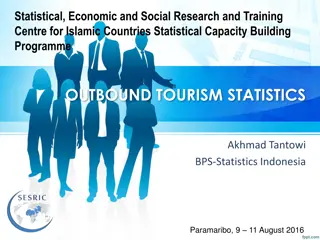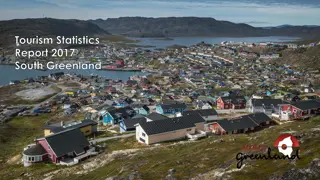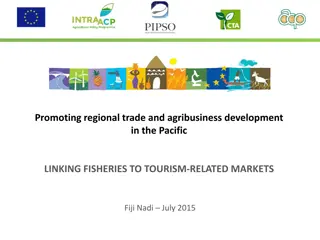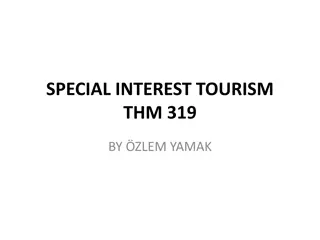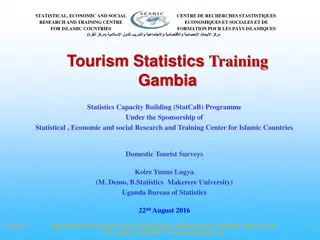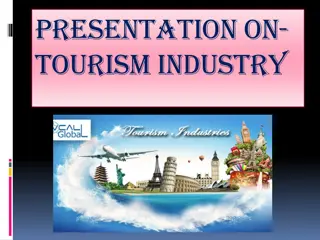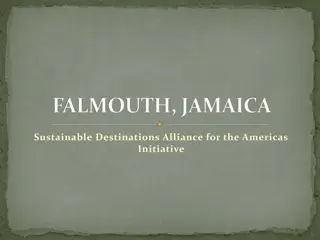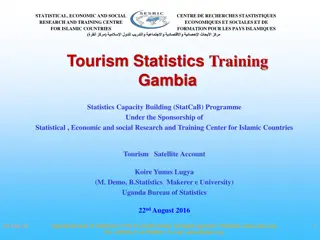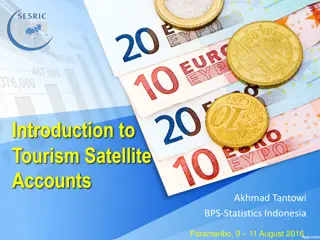Economic Impact of Tourism in New York State 2017: Key Trends and Insights
New York State's tourism economy experienced significant growth in 2017, with a 4.4% increase in traveler spending, reaching a record high of $67.6 billion. This growth led to substantial impacts on total business sales, income generation, and tax contributions, highlighting the importance of tourism to the state's economy and labor market. Furthermore, the analysis showcases the distribution of traveler spending across different markets, emphasizing the diverse sources contributing to New York State's tourism sector.
Download Presentation

Please find below an Image/Link to download the presentation.
The content on the website is provided AS IS for your information and personal use only. It may not be sold, licensed, or shared on other websites without obtaining consent from the author.If you encounter any issues during the download, it is possible that the publisher has removed the file from their server.
You are allowed to download the files provided on this website for personal or commercial use, subject to the condition that they are used lawfully. All files are the property of their respective owners.
The content on the website is provided AS IS for your information and personal use only. It may not be sold, licensed, or shared on other websites without obtaining consent from the author.
E N D
Presentation Transcript
The Economic Impact of Tourism in New York 2017 Calendar Year Catskills Focus 1st place winner: Buoy Boat by Dale Evva Gelfand (2009)
Key trends in 2017 New York State s tourism economy expanded in 2017 with 4.4% growth in traveler spending, reaching a new high of $67.6 billion-- 27% above the state s pre-recession peak set in 2008. Key data illustrate the industry s performance: Room demand expanded 3.8% in 2017. However, a slight decline in room rates of 0.4% led to a total hotel revenue increase of 3.4% according to STR. Passenger counts at all NYS airports increased 2.3% in 2017, though associated ticket revenue declined for the third consecutive year (down 3.3%). Personal income climbed 6.0% over the prior year, outpacing the general economy. 3
Headline results Travel & tourism is a substantial and growing component of the New York State economy. Direct spending of $67.6 billion generated nearly $109 billion in total business sales including indirect and induced impacts. Total income of $36.5 billion was sustained by tourism activity in 2017. New York State tourism generated $8.5 billion in state and local taxes in 2017, saving each NYS household an average of $1,172 in taxes. 4
Tourism is vital to the NYS labor market Unemployment Rate in New York State 2017 14.0% 12.9% 12.0% 10.0% 8.0% 6.0% 4.7% 4.0% 2.0% 0.0% Unemployment rate Unemployment rate without tourism Source: BLS, Tourism Economics The unemployment rate in New York State was 4.7% in 2017. If the jobs sustained by travelers were eliminated, the unemployment rate would rise to 12.9%. 5
Traveler spending growth Traveler spending continued to expand in 2017, growing 4.4%. Excluding purchases of gasoline, traveler spending expanded 3.2% last year. New York Traveler Spending % change $ billions TOTAL % change $80 10% $70 5% $60 As a result, the tourism economy reached another high in 2017, with $67.6 billion in traveler spending. $50 0% $40 -5% $30 $20 -10% $10 Traveler spending growth has averaged 4.5% per year since the recovery began in 2010 (compound annual growth). $- -15% 2008 2011 2014 2017 Source: Tourism Economics 6
New York State tourism markets Traveler Spending by Market, 2017 US domestic markets supplied 70% ($47.2 bn) of the New York State s traveler spending base in 2017. Overseas 28% International markets represented 30% ($20.4 bn) of the spending base. Canada 2% Domestic 70% Source: Tourism Economics 7
Broad-based growth Travelers increased their spending across all sectors except transportation in 2017. Higher prices for food and fuel factored into increase in traveler spending. Traveler Spending By Sector Billion $ 2012 2013 2014 2015 2016 2017 25 20 15 10 Spending increased the most in retail and service stations, as gas prices rose significantly over the prior year. 5 - Lodging Food Service Transport Retail & Svc Stations Recreation Growth was also strong in the food service and recreation sectors, increasing 5.1% and 4.8%, respectively, over 2016. Source: Tourism Economics 8
Traveler spending distribution Traveler spending is diverse and well-distributed across multiple sectors of the economy. While spending shares remained similar to 2016, higher fuel prices shifted traveler spending back to transportation. Traveler Spending by Sector, 2017 Traveler Spending by Sector, 2016 Retail & Svc Stations 17% Retail & Svc Stations 18% Transport 19% Transport 19% Recreation 10% Recreation 10% Lodging 29% Lodging 30% Food Service 24% Food Service 24% Source: Tourism Economics Source: Tourism Economics 9
Historic traveler spending by sector NYS Traveler Spending, millions Transport Lodging Food Service Recreation Retail & Svc Stations TOTAL % change 2005 2006 2007 2008 2009 2010 2011 2012 2013 2014 2015 2016 2017 $ $ $ $ $ $ $ $ $ $ $ $ $ 6,453 6,587 7,361 7,610 6,626 10,108 10,875 11,504 11,740 12,473 12,853 12,719 12,712 -0.1% $ $ $ $ $ $ $ $ $ $ $ $ $ 11,575 12,832 14,301 14,710 12,208 13,873 15,155 16,267 17,180 18,292 18,714 19,327 19,958 3.3% $ $ $ $ $ $ $ $ $ $ $ $ $ 9,663 10,565 11,357 11,492 10,511 11,313 11,806 12,379 12,953 13,676 14,502 15,375 16,166 5.1% $ $ $ $ $ 4,259 4,668 5,191 5,336 4,668 4,817 5,019 5,332 5,498 5,863 6,183 6,454 6,767 4.8% $ $ $ $ $ $ $ $ $ $ $ $ $ 4,615 4,950 5,360 5,462 4,471 9,664 11,055 11,775 11,874 12,152 10,825 10,912 12,030 10.2% $ $ $ $ $ $ $ $ $ $ $ $ $ 43,431 46,574 51,081 53,108 45,777 49,775 53,910 57,257 59,245 62,456 63,077 64,787 67,633 4.4% 8.6% 7.2% 9.7% 4.0% -13.8% 8.7% 8.3% 6.2% 3.5% 5.4% 1.0% 2.7% 4.4% $ $ $ $ $ $ $ $ 2017 % change 10
Traveler spending by market NYS Traveler Spending by Market Domestic 35,075 $ 37,579 $ 40,050 $ 41,030 $ 43,533 $ 44,045 $ 45,570 $ 47,219 $ Canada $ $ $ $ $ $ $ $ Overseas 13,396 $ 14,937 $ 15,711 $ 16,661 $ 17,285 $ 17,493 $ 17,755 $ 18,858 $ Total 49,775 $ 53,910 $ 57,257 $ 59,245 $ 62,456 $ 63,077 $ 64,787 $ 67,633 $ 2010 2011 2012 2013 2014 2015 2016 2017 1,304 1,395 1,495 1,554 1,638 1,540 1,461 1,556 15.2% 7.0% 7.2% 3.9% 5.4% -6.0% -5.1% 6.5% 2010 Growth 2011 Growth 2012 Growth 2013 Growth 2014 Growth 2015 Growth 2016 Growth 2017 Growth 5.8% 7.1% 6.6% 2.4% 6.1% 1.2% 3.5% 3.6% 16.7% 11.5% 5.2% 6.0% 3.7% 1.2% 1.5% 6.2% 8.7% 8.3% 6.2% 6.2% 5.4% 1.0% 2.7% 4.4% Spending from all market segments increased, led by international travelers. Following a lackluster 2016, visitation and spending bounced back for both Canadian and overseas travelers alike. Despite strong growth from those markets, domestic spend remains the highest in terms of levels. 11
How traveler spending generates impact Travelers create direct economic value within a discreet group of sectors (e.g. recreation, transportation). This supports a relative proportion of jobs, wages, taxes, and GDP within each sector. Each directly affected sector also purchases goods and services as inputs (e.g. food wholesalers, utilities) into production. These impacts are called indirect impacts. Lastly, the induced impact is generated when employees whose incomes are generated either directly or indirectly by tourism, spend those incomes in the city economy. 12
Traveler-generated sales Including the indirect and induced impacts, traveler spending generated nearly $109 billion in business sales in 2017, increasing 3.7%. Tourism Sales (Output) (US$ Million, 2017) Direct* Indirect Induced Total % change 2.8% 2.8% 2.7% 2.7% -1.0% 2.2% 2.8% 20.6% 2.7% 2.6% 2.8% 2.6% 4.7% 3.4% 5.0% 2.7% 2.6% 3.7% Agriculture, Fishing, Mining Construction and Utilities Manufacturing Wholesale Trade Air Transport Other Transport Retail Trade Gasoline Stations Communications Finance, Insurance and Real Estate Business Services Education and Health Care Recreation and Entertainment Lodging Food & Beverage Personal Services Government TOTAL % change Note: Direct Sales include cost of goods sold for retail and gasoline stations - - - - 445 1,285 2,138 1,336 189 608 1,761 1,242 633 1,893 3,899 2,578 8,533 5,968 9,058 5,494 2,147 8,952 8,425 3,844 7,361 17,801 17,494 1,200 3,440 108,720 3.7% 8,409 4,303 6,621 5,408 - 2,418 - - 6,767 17,541 16,166 55 70 425 2,097 1,240 340 13 73 775 2,933 1,768 3,820 264 141 878 831 2,929 20,803 2.6% 1,372 3,602 6,657 24 330 119 450 368 511 - - 67,633 4.4% 20,284 2.8% 13
Traveler-generated sales Traveler-Generated Sales by Industry $ million Induced Significant indirect benefits 18,000 Indirect 16,000 Direct 14,000 12,000 10,000 8,000 6,000 4,000 2,000 0 Recreation Wholesale Trd Retail Trd Educ, Health Restaurants FIRE Other Transp Lodging Gas stations Business Svc Manufacturing Air Transport Government * Direct sales include cost of goods sold for retail ** Air transport includes local airline and airport operations, including sales generated by inbound visitors, plus outbound and transit passengers *** FIRE = Finance, Insurance, and Real Estate 14
Traveler-generated income Tourism Income (Compensation) (US$ Million, 2017) Direct Indirect Induced Total % change 4.4% 4.4% 4.4% 4.4% 3.5% 3.8% 3.8% 4.1% 4.4% 4.2% 4.4% 4.5% 4.8% 8.4% 6.1% 4.4% 4.4% 5.4% Agriculture, Fishing, Mining Construction and Utilities Manufacturing Wholesale Trade Air Transport Other Transport Retail Trade Gasoline Stations Communications Finance, Insurance and Real Estate Business Services Education and Health Care Recreation and Entertainment Lodging Food & Beverage Personal Services Government TOTAL % change - - - - 84 369 366 498 17 671 137 47 152 309 473 22 185 862 23 195 971 884 2,127 124 131 521 675 971 2,939 2,448 1,907 437 612 2,309 3,829 2,140 2,690 7,385 6,737 542 212 36,484 5.4% 2,899 1,592 909 410 - 344 - - 2,383 7,290 6,246 - - 22,073 6.0% 4 416 994 2,945 13 183 44 164 157 133 7,195 4.3% 51 327 385 79 7,215 4.5% Tourism-generated income grew 5.4% as a function of both employment growth and pay increases, registering $36.5 billion in 2017. 15
Traveler-generated income Traveler-Generated Income by Industry $ million 8,000 Induced 7,000 Indirect 6,000 Direct 5,000 4,000 3,000 2,000 1,000 0 Recreation Wholesale Trd Retail Trd Educ, Health Personal Svc FIRE Other Transp Communications Manufacturing Restaurants Lodging Business Svc Air Transport FIRE = Finance, Insurance, and Real Estate 16
Tourism tax generation Travel-Generated Taxes (US$ Million, 2017) Tourism generated nearly $17.9 billion in taxes in 2017, growing 4.3%. Total Federal Taxes Corporate Indirect Business Personal Income Social Security 9,334.2 1,571.3 705.6 3,333.0 3,724.4 Total state and local tax proceeds of $8.5 billion saved the state s households an average of $1,172 in tax burden. State and Local Taxes Corporate Personal Income Sales Property Excise and Fees State Unemployment 8,517.2 1,673.4 1,441.2 2,557.0 2,374.5 336.6 134.4 TOTAL % change 17,851.4 4.3% 17
Tourism tax generation: State vs. Local Travel-Generated Taxes (US$ Million) Tax Type 2010 2,784.3 535.2 857.38 1,143.09 2011 2,974.8 574.3 908.6 1,226.5 2012 3,142.3 609.0 950.7 1,300.6 2013 3,250.4 631.0 980.2 1,347.6 2014 3,413.1 662.8 1,028.4 1,415.6 2015 3,498.3 674.2 1,069.9 1,439.9 2016 3,614.8 692.4 1,118.6 1,478.8 2017 3,719.4 708.0 1,154.6 1,517.5 State Tax Subtotal Corporate Personal Income Sales Property Excise and Fees State Unemployment 0.0 0.0 0.0 0.0 0.0 0.0 0.0 0.0 150.83 97.8 161.8 103.6 173.6 108.4 179.9 111.8 189.0 117.3 192.2 122.0 197.4 127.6 204.8 134.4 Local Tax Subtotal Corporate Personal Income Sales Property Excise and Fees State Unemployment 3,710.9 711.6 191.0 762.1 1,949.2 97.0 3,905.1 763.5 202.4 817.6 2,017.5 104.1 4,095.6 809.6 211.8 867.0 2,095.5 111.7 4,226.9 838.9 218.4 898.4 2,155.6 115.7 4,424.8 881.2 229.1 943.7 2,249.2 121.6 4,505.1 896.3 238.4 959.9 2,286.8 123.6 4,614.2 920.5 249.2 985.9 2,331.6 127.0 4,797.7 965.4 286.5 1,039.5 2,374.5 131.7 0.0 0.0 0.0 0.0 0.0 0.0 0.0 0.0 Tourism generated $3.7 billion in state taxes, and $4.8 billion in local taxes in 2017. 18
Traveler spending by region Traveler Spending, 2017 New York State is divided into 11 economic regions. Finger Lakes 5% Thous. Islands 1% Chautauqua- Allegheny 1% Niagara 4% New York City is the largest single tourism region with 65% of state visitor spend. Adirondacks 2% Cen. New York 3% Capital-Saratoga 3% Catskills 2% New York City, Long Island and Hudson Valley together comprise nearly 80% of New York State traveler spend. Hudson Valley 5% Long Island 9% New York City 65% 20
Upstate traveler spending by region Upstate Traveler Spending, 2017 Chautauqua- Allegheny 3% Niagara 15% Traveler spending across the upstate regions of New York is more evenly distributed (excludes NYC and Long Island). Hudson Valley 21% Catskills 8% Finger Lakes 17% Thous. Islands 3% Capital-Saratoga 12% Cen. New York 13% Adirondacks 8% 21
Reliance on tourism Tourism Share of Regional Employment in 2017 Tourism is an integral part of every region s economy, generating from 6% to 19% of employment. 20.0% 18.0% 16.0% Direct Tourism Total Tourism 14.0% 12.0% 10.0% Tourism is most important to the Adirondacks and Catskills, generating 19% and 16% of total employment, respectively. 8.0% 6.0% 4.0% 2.0% 0.0% Chaut.-Allegheny Long Island Adirondacks New York City Catskills Capital-Saratoga Cen. New York Niagara Thous. Islands Hudson Valley Finger Lakes Note: All regional and county tourism shares are calculated using QCEW (ES-202) employment and wage totals as produced by the NYS Dept. of Labor. 22
Traveler spending growth Traveler spending increased in all regions in 2017, generally at a lower rate than in 2016. Growth in Traveler Spending 14.0% The strongest growth occurred in the Catskills, Central New York, Adirondacks, and Greater Niagara regions. 12.0% 10.0% 8.0% 6.0% 4.0% Growth in traveler spending was led by recreation and food & beverage spending. Additionally, higher fuel prices contributed to an increase in service spending. 2.0% 0.0% Catskills Niagara Thous. Islands Cen. New York Capital-Saratoga New York City Adirondacks Hudson Valley New York State New York excl. NYC Finger Lakes Chautauqua-Allegheny Long Island 2016 2017 23
Regional growth Traveler Spend Year-Over-Year Comparison 2017 / 2016 % Traveler Spend '000s 2015 2016 2017 1. Chautauqua-Allegheny 2. Greater Niagara 3. Finger Lakes 4. Thousand Islands 5. Adirondacks 6. Central New York 7. Capital-Saratoga 8. Catskills 9. Hudson Valley 10. Long Island 11. New York City TOTAL $ $ $ $ $ $ $ $ $ 539,075 2,441,645 2,916,899 496,885 1,302,981 2,089,682 1,879,644 1,170,425 3,419,906 5,479,761 41,339,411 63,076,313 $ $ $ $ $ $ $ $ $ $ 541,924 2,527,005 2,977,992 521,599 1,347,424 2,223,911 1,922,968 1,232,096 3,536,433 5,646,539 42,308,741 $ 64,786,632 $ 552,847 2,666,342 3,048,050 543,319 1,421,767 2,351,046 2,010,982 1,319,364 3,664,056 5,870,546 44,184,748 $ 67,633,067 $ $ $ $ $ $ $ $ $ $ $ 2.0% 5.5% 2.4% 4.2% 5.5% 5.7% 4.6% 7.1% 3.6% 4.0% 4.4% 4.4% Business Day $ $ $ 24
Regional tourism summary (2017) Tourism Economic Impact Combined Direct, Indirect, and Induced Tourism Economic Impact Direct Sales, '000s 552,847 $ 2,666,342 $ 3,048,050 $ 543,319 $ 1,421,767 $ 2,351,046 $ 2,010,982 $ 1,319,364 $ 3,664,056 $ 5,870,546 $ 44,184,748 $ 67,633,067 $ Labor Income, '000s 248,785 $ 1,472,224 $ 1,529,162 $ 239,051 $ 678,793 $ 1,348,464 $ 1,104,632 $ 607,323 $ 2,060,957 $ 3,166,774 $ 24,027,358 $ 36,483,522 $ Employment, Persons 410,310 797,397 Local Taxes, '000s $ 179,277 $ 229,547 $ $ $ 147,422 $ 137,741 $ $ 244,821 $ 398,928 $ 3,198,932 $ 4,797,741 $ State Taxes, '000s $ 146,634 $ 167,626 $ $ $ 129,270 $ 110,593 $ $ 201,503 $ 322,847 $ 2,429,913 $ 3,719,415 $ 1. Chautauqua-Allegheny 2. Greater Niagara 3. Finger Lakes 4. Thousand Islands 5. Adirondacks 6. Central New York 7. Capital-Saratoga 8. Catskills 9. Hudson Valley 10. Long Island 11. New York City TOTAL 11,172 53,168 58,242 9,194 21,347 37,583 37,593 18,542 58,539 81,707 39,448 30,403 35,991 99,352 29,879 78,189 86,283 72,558 Business Day 25
Regional tourism impact distribution (2017) Tourism Economic Impact Regional Shares Tourism Distribution Sales Labor Income Employment Local Taxes State Taxes 1. Chautauqua-Allegheny 2. Greater Niagara 3. Finger Lakes 4. Thousand Islands 5. Adirondacks 6. Central New York 7. Capital-Saratoga 8. Catskills 9. Hudson Valley 10. Long Island 11. New York City TOTAL 1% 4% 5% 1% 2% 3% 3% 2% 5% 9% 65% 100% 1% 4% 4% 1% 2% 4% 3% 2% 6% 9% 66% 100% 1% 7% 7% 1% 3% 5% 5% 2% 7% 10% 51% 100% 1% 4% 5% 1% 2% 3% 3% 2% 5% 8% 67% 100% 1% 4% 5% 1% 2% 3% 3% 2% 5% 9% 65% 100% Business Day 26
Regional Detail for Catskills Business Day 27
Catskills, county distribution Traveler Spending, 2016 Tourism in the Catskills is a $1.3 billion industry, supporting 18,542 jobs. Delaware 8% Ulster County represents 45% of the region s tourism sales with $587 million in traveler spending. Greene 13% Ulster 45% Traveler spending in the region grew by 7.1% in 2017. Sullivan 34% Business Day 28
Catskills, total tourism impact Total Tourism Impact, 2017 Delaware Greene Sullivan Ulster TOTAL Traveler Spend '000 $111,908 $170,762 $449,711 $586,983 $1,319,364 Labor Income, '000 $38,430 $78,179 $186,467 $304,248 $607,323 Employment Local Taxes '000 State Taxes '000 1,125 3,205 5,004 9,208 18,542 $6,689 $11,348 $29,098 $39,148 $86,283 $6,154 $9,391 $24,732 $32,281 $72,558 29
Catskills, traveler spending Traveler Spending, 2017 Travelers spent $1.3 billion in the Catskills region in 2017 across a diverse range of sectors. Second Homes 24% Lodging 37% Spending on lodging and expenses related to second homes comprised 37% and 24% of the total, respectively. Transport 4% Retail & Svc Stations 16% Recreation 3% Business Day F&B 16% 30
Catskills, traveler spending 2017 Traveler Spend '000s Delaware Greene Sullivan Ulster TOTAL Retail & Svc Stations Second Homes $75,687 $52,170 $145,439 $47,818 $321,114 Lodging Recreation F&B Transport Total $13,758 $43,623 $184,159 $242,260 $483,800 $2,114 $9,145 $9,448 $14,851 $35,558 $11,458 $29,443 $44,191 $127,346 $212,438 $7,961 $24,758 $63,581 $111,066 $207,366 $930 $111,908 $170,762 $449,711 $586,983 $1,319,364 $11,622 $2,894 $43,642 $59,088 31
Regional growth 2017 / 2016 % Traveler Spend '000s 2015 2016 2017 Delaware Greene Sullivan Ulster TOTAL $ $ $ $ $ 98,056 151,997 388,059 532,314 1,170,425 $ $ $ $ $ 100,303 158,417 419,216 554,160 1,232,096 $ $ $ $ $ 111,908 170,762 449,711 586,983 1,319,364 11.6% 7.8% 7.3% 5.9% 7.1% 2017 / 2016 % State Taxes, $ 2015 2016 2017 Delaware Greene Sullivan Ulster TOTAL 5,437,879 8,429,249 21,520,504 29,520,432 64,908,064 5,596,414 8,838,923 23,390,287 30,919,480 68,745,103 6,154,310 9,390,937 24,731,579 32,280,743 72,557,569 10.0% 6.2% 5.7% 4.4% 5.5% 2017 / 2016 % Local Taxes, $ 2015 2016 2017 Delaware Greene Sullivan Ulster TOTAL 6,332,665 10,150,733 25,890,332 36,164,406 78,538,135 6,501,997 10,615,413 28,124,634 37,824,833 83,066,876 6,689,199 11,347,635 29,098,350 39,147,665 86,282,849 2.9% 6.9% 3.5% 3.5% 3.9% 32
Catskills, labor income Tourism-Generated Labor Income $350 $300 Direct Indirect/Induced $250 Millions $200 $150 $100 $50 $0 Delaware Greene Sullivan Ulster Business Day Tourism in the Catskills region generated $367 million in direct labor income and $607 million including indirect and induced impacts. Tourism is most significant in Ulster County, generating $304 million in labor income, including indirect and induced impacts. 33
Catskills, labor income Tourism-Generated Labor Income Share of Economy, 2017 12.5% of all labor income in the Catskills region is generated by tourism. TOTAL Share (Total) Share (Direct) Sullivan County is the most dependent upon tourism with 17.2% of all labor income generated by visitors. Ulster Sullivan Greene Delaware 0.0% 5.0% 10.0% 15.0% 20.0% Share of Economy 34
Catskills, labor income 2017 Tourism Labor Income, '000 Delaware Greene Sullivan Ulster TOTAL Total (Direct, Indir., Induced) Direct Share (Direct) Share (Total) $23,251 $47,300 $112,817 $184,078 $367,446 $38,430 $78,179 $186,467 $304,248 $607,323 3.7% 7.9% 10.4% 7.2% 7.5% 6.2% 13.1% 17.2% 11.8% 12.5% 35
Catskills, tourism employment Tourism-Generated Employment Share of Economy, 2017 15.9% of all employment in the Catskills region is generated by tourism. TOTAL Share (Total) Ulster Share (Direct) Sullivan Greene County is the most dependent upon tourism with 22.0% of all employment sustained by visitors. Greene Delaware 0.0% 5.0% 10.0% 15.0% 20.0% 25.0% Share of Economy Business Day 36
Catskills, tourism employment Tourism-Generated Employment, 2017 2017 Tourism Employment Delaware Greene Sullivan Ulster TOTAL Total (Direct, Ind., Induced) Direct Share (Direct) Share (Total) 791 1,125 3,205 5,004 9,208 18,542 5.4% 15.5% 13.1% 10.7% 11.2% 7.7% 22.0% 18.7% 15.2% 15.9% 2,253 3,519 6,475 13,039 10,000 9,000 8,000 Direct Indirect/Induced 7,000 6,000 5,000 4,000 3,000 2,000 1,000 0 Delaware Greene Sullivan Ulster 37
Catskills, tourism taxes Tourism-Generated Taxes, 2017 Tourism in the Catskills region generated $159 million in state and local taxes in 2017. $80 Millions $70 Local State $60 Sales, property, and hotel bed taxes contributed $86 million in local taxes. $50 $40 $30 Ulster County produced 45% of the region s tourism tax base in 2017. $20 $10 $0 Business Day Delaware Greene Sullivan Ulster 38
Catskills, tourism taxes Tourism-Generated Taxes, 2017 Delaware Greene Sullivan Ulster TOTAL Tax Savings per Household Local Taxes State Taxes Total Region Share $6,689,199 $11,347,635 $29,098,350 $39,147,665 $86,282,849 $6,154,310 $9,390,937 $24,731,579 $32,280,743 $72,557,569 $12,843,509 $20,738,572 $53,829,928 $71,428,409 $158,840,418 8.1% 13.1% 33.9% 45.0% 100.0% $683 $1,211 $1,922 $1,030 $1,192 Were it not for tourism-generated state and local taxes, the average household in the region would have to pay an additional $1,192 to maintain the same level of government revenue. 39
Methods and data sources Household travel surveys from Longwoods International have provided key inputs in establishing traveler spending figures. This is a representative survey with a sample of more than 300,000 trips per year. Industry data on lodging, airport activity, Amtrak, and attractions inform year-over-year growth analysis. Employment definitions. The basis of our data and modeling is the Regional Economic Information System (REIS), Bureau of Economic Analysis, U.S. Department of Commerce. This is different than the NYS Department of Labor data source (ES202/QCEW). The main definitional difference is that sole-proprietors, which do not require unemployment insurance and are not counted in the ES202 data. For total employment (across all sectors), the difference is 20%. International methodology. Our approach is based the estimates on direct survey responses to the Department of Commerce in-flight survey and Statistics Canada data - constrained to BEA international balance of payments data. All employment and income results are constrained to known industry measurements for key tourism sectors. 40
Methods and data sources Local taxes are a build-up of individual categories (sales, occupancy, property). The model is not equipped to deal with individual exemptions such as Indian gaming. Second home expenditures are based on the stock of seasonal second home inventory. Annual average expenditures for housing are pro-rated to the season length to account for various levels of expenditures not accounted in visitor surveys. Lodging sector. Our models use survey information and constrains this to the value of the hotel sector in each county. This can vary from certain bed tax estimates of total revenue for several reasons. One is that the bed tax may only be based on room revenue while total sales for the industry may include other revenue sources (room service, phone, etc.). Another is that certain smaller establishments may not fully report or be required to report their revenue. 41
Methods and data sources Tourism Economics utilized the IMPLAN input-output model for New York State to track the flow of sales through the economy to the generation of GDP, employment, wages, and taxes. The impacts are measured on three levels: Direct impact: The immediate benefit to persons and companies directly providing goods or services to travelers. Indirect impact: The secondary benefit to suppliers of goods and services to the directly-involved companies. For example, a food wholesaler providing goods to a restaurant. The model is careful to exclude imports from the impact calculations. Induced impact: The tertiary benefit to the local economy as incomes in the prior two levels of impact are spent on goods and services. For example, a restaurant employee spends his wages at a grocery store, generating addition economic output. 42
About Tourism Economics Tourism Economics, headquartered in Philadelphia, is an Oxford Economics company dedicated to providing high value, robust, and relevant analyses of the tourism sector that reflects the dynamics of local and global economies. By combining quantitative methods with industry knowledge, Tourism Economics designs custom market strategies, project feasibility analysis, tourism forecasting models, tourism policy analysis, and economic impact studies. Our staff have worked with over 100 destinations to quantify the economic value of tourism, forecast demand, guide strategy, or evaluate tourism policies. Oxford Economics is one of the world s leading providers of economic analysis, forecasts and consulting advice. Founded in 1981 as a joint venture with Oxford University s business college, Oxford Economics is founded on a reputation for high quality, quantitative analysis and evidence-based advice. For this, it draws on its own staff of 40 highly-experienced professional economists; a dedicated data analysis team; global modeling tools; close links with Oxford University, and a range of partner institutions in Europe, the US and in the United Nations Project Link. For more information: info@tourismeconomics.com. 43
For more information: +1.610.995.9600, info@tourismeconomics.com 44
